
|
|
 |
|
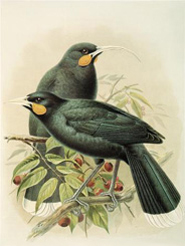 |
|
 |
|
 |
|
| |

|
|
| |
|
| |
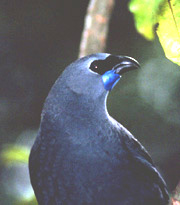 |
|
|
|
|
|
 |
|
|
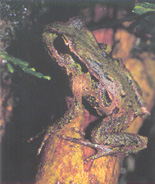 |
|
| |
 |
|
 |
| |
Lead-free Lee gets weight back
"A kakapo has slowly been nursed back to health at Auckland Zoo after his body weight nearly halved from lead poisoning..."
New Zealand Herald
27 October 2008
World kakapo population rises by five
"Critically endangered kakapo are having a good year. Five chicks hatching in the last two weeks have boosted the population..."
New Zealand Herald
31 March 2008
Kakapo to be shown to public
"Demand is expected to be high as one of the least viewed animals on Earth goes on public display in New Zealand for the first time..."
New Zealand Herald
23 June 2006
Test-tube kakapo in the pipeline
"The first artificial insemination of one of New Zealand's rarest birds could begin as early as this year after the last great kakapo hunt ended in failure..."
New Zealand Herald
17 February 2006
Kiwi and Kakapo at risk from bird flu
"The kiwi and kakapo are two of the species that would be most at threat from a bird flu outbreak reaching this country..."
New Zealand Herald
17 January 2006
Kakapo hunt ready to begin
"A mission to find a critically endangered New Zealand bird in the wild is being given a one-in-five chance..."
New Zealand Herald
17 January 2006
Aggressive kakapo banished to Fiordland
"An aggressive male kakapo has been banished after it assaulted a kakapo chick in one of the acclimatisation pens on isolated Codfish Island..."
New Zealand Herald
22 September 2005
Under-sexed kakapo need DoC attention
"Kakapo are not having enough sex and the Department of Conservation aims to do something
about it."
New Zealand Herald
4 April 2005
Rare parrots lay a record
"Two months ago the world could boast just 62 kakapo, the world's rarest parrot.
Today that number has risen by a third, to 84 birds, thanks to a bumper
brood of chicks ..."
BBC NEWS
20 March 2002 |
|
|
| |
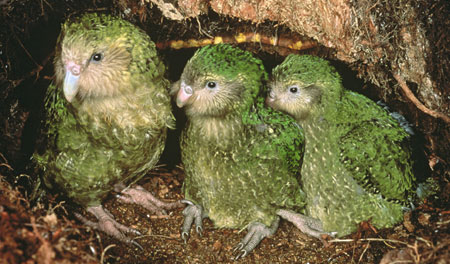 |
| |
 |
| |
The kakapo is one of the most outrageously funny, loving and strangest birds in a land renowned for unusual creatures. Life moves very slowly for the kakapo - it seems locked in another time. It is slow to breed and lives longer than any other bird. It has hung on, with no known female it was effectively extinct for three-quarters of the 20th century, and dangerously close to extinction during the last quarter century. For three decades, kakapo have had help in the most extensive protected breeding programme, which has increased the population from the low point of 51 birds to 103. |
| |
| |
The kakapo Strigops habroptilus belongs to the family Strigopidae of New Zealand parrots, which has only two other members, the kea Nestor notabilus and kaka N. meridionalis. The Strigopidae family is one of three in the Psittaciformes order of parrots.
The kakapo is the only species the genus Strigops. Its' combination of biological features is not found in any other species. It is endemic to New Zealand - so unique it is a 'national treasure'.
Kakapo were once abundant throughout New Zealand. West Coast explorer Charlie Douglas said "birds used to be in dozens round the camp, screeching and yelling like a lot of demons, and at times it was impossible to sleep for the noise ... you could shake a tree and the kakapo would fall down like apples". Many workers in the bush lived on the delicious, fruity white meat that is as good as any farm raised fowl.
Maori enthusiastically hunted kakapo, and the dogs and kiore they introduced cut a further swathe through the population. Kakapo had pretty much disappeared from the North Island by the time Europeans settled in the 19th century. By 1890 kakapo could not be found in the North Island, and were in serious decline in the South Island.
When kakapo were only in remote wilderness, they remained vulnerable to introduced stoats, the number one enemy that eats eggs and chicks of New Zealand's endangered birds.
It is most puzzling to see a bird that cannot fly perched high in a tree. Kakapo are accomplished climbers, using their wings for balance, and their beak and strong claws to pull and grip their way up and down trees and vines.
When roosting they are difficult to see, even at just an arms length. Mottled green plumage that resembles moss provides perfect camouflage. As kakapo sit perfectly motionless it may only be the blink of an eye that gives them away. This would have helped them avoid attack from the only potential native predator, the extinct giant Haast's eagle.
Since human settlement, the strong musty smell of kakapo, which can be described as sweet smelling like honey or flowerlike, has made it easy for introduced mammal predators to find them. |
| |
|
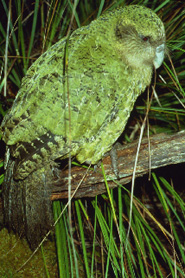
The world's heaviest, and only flightless, nocturnal parrot .....
Kakapo hold quite a few world records. It is the only flightless parrot, and the only nocturnal parrot. And it is the world's heaviest parrot, with males weighing up to 4 kg. Females are 65 percent of the weight of males.
The kakapo is not biologically close to other parrot species. Sometimes called the night parrot, or owl-parrot, it has some features of an owl, such as fur-like discs around its' eyes, and soft feathers.
Kakapo have an estimated life span of 80 to 100 years, possibly the longest of any bird. It should also go on record as the gentlest, most peaceful, adorable creature.
Kakapo in the wild are remarkably friendly towards humans. Some early settlers kept kakapo as pets, finding them better company, more affectionate, funnier, sweeter smelling, and more intelligent than a cat or dog. Kakapo in the wild will climb up a person's leg and arm to perch on the shoulder, and then provide hair preening and a gentle ear nibble.
Unfortunately kakapo are not afraid of predators. They could mame a stoat with their strong legs and feet, but remain passive towards them. The kakapo's naive trust and tasty flesh made it easy game for Maori and European settler cooking pots. |
|
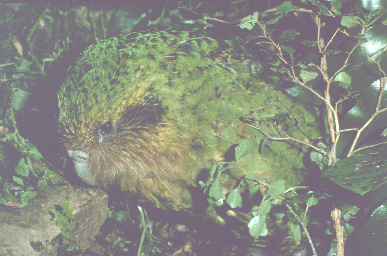 |
| |
Richard Henry is the last remaining kakapo of the males found in Fiordland in the mid-1970s. He is now more than 50 years old, and has fathered three chicks in two years, providing a valuable addition to the gene pool on Codfish Island which is predominated by the Stewart Island population. Inbreeding is thought to be a significant reason for the kakapo's low fertilty rate.
Image Crown Copyright © Department of Conservation |
| |
 |
| |
The incredible mating ritual of kakapo .....
 Listen to the booming call of a male kakapo Listen to the booming call of a male kakapo
Requires RealPlayer to run
 INSTALL REALPLAYER INSTALL REALPLAYER
One of many, and the strangest peculiarity of the kakapo is its' mating ritual known as lekking. It is the only parrot or flightless bird with a lek mating procedure.
In breeding seasons which occur every 3 to 5 years coincidental with abundant seeding/fruiting (masting) seasons, male kakapo occupy a network of meticulously kept tracks connected to bowls in display grounds that resemble an archaeological site of a lost civilisation. These areas are thought to have been continually used for hundreds or possibly thousands of years.
In order to attract females, the male makes a loud, low-frequency booming call, a deep sound somewhat similar to a foghorn, that resonates through valleys and carries as far as 5 kilometres. Some lekking areas have been found strategically located next to rock faces, which causes amplification of the sound.
|
|
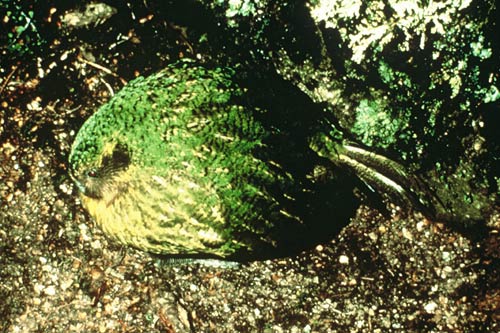
Male kakapo booming, Stewart Island 1980s. Ralph Powlesland, Crown Copyright © Department of Conservation

The kakapo is the only parrot with an inflatable thoracic air sac. The male puffs up his entire body to the size of a basketball, and will remain in this state throughout the night.
He booms while sitting in a half-metre-wide bowl in the ground, rotating his body to broadcast the courtship to the whole area.
The booming rate is as much as 15 or 16 times a minute, and may continue for 17 hours. The courtship calling will extend for a period of up to four months in a breeding year. |
| |
 |
| |
|
 |
| |
Kakapo donations to Terra Nature Fund will be applied to predator control, assisted breeding, monitoring, and translocations by the Dept of Conservation. Donations to Terra Nature Fund may be tax deductible in the United States, whereas gifts directly to New Zealand organisations are not. |
| |
Images above and left: Crown Copyright © Department of Conservation
 View 9 images of female kakapo and chicks View 9 images of female kakapo and chicks
 Kakapo Recovery Programme Kakapo Recovery Programme
 Threatened Species Trust Threatened Species Trust
 Listen to the incredible booming call of a male kakapo Listen to the incredible booming call of a male kakapo
Requires RealPlayer to run
 INSTALL REALPLAYER INSTALL REALPLAYER
 See "Kakapo population breaks 100" See "Kakapo population breaks 100" |
| |
| |
 |
| |
2008 IUCN Red List of Threatened Species
Kakapo
Strigops habroptilus
Critically endangered
United States Threatened and Endangered Species, Foreign Listed Species
Kakapo
Strigops habroptilus
Endangered
2008 New Zealand Threat Classification System
Kakapo
Strigops habroptilus
[1] Nationally critical |
| |
| |
 |
| |
A slow, meticulously executed 'edge ecology' comeback ...
The most spectacular, on the edge, brink of extinction rescue in New Zealand was bringing back the Chatham Island black robin, after finding the sole surviving female, that could then choose from 4 remaining males. It does not come much closer than that, but the kakapo must surely run a close second to the black robin as an 'edge' survivor.
The rapid decline of kakapo came perilously close to extinction. From 1949 until 1973, after the NZ Wildlife Service realised extinction was about to occur, search expeditions were conducted in northwest Nelson, the Tararua Range and Fiordland.
During the 1960s six male kakapo were found in the Tutuko Valley at Milford Sound and Sinbad Gully beneath Mitre Peak. All of these birds died after transfer to the Mount Bruce National Wildlife Centre, at a time when little was known of their habits.
It was not until 1974 that an old and worn male, who was named Jonathon Livingston, was discovered in Esperance Valley by Don Merton. There was elation from catcher and bird alike at the meeting. A clever trick of broadcasting kakapo calls was used to locate birds, who eagerly returned calls.
Eighteen kakapo were found and caught in Fiordland, but unfortunately they were all
males.
As no female had been sighted for more than 70 years, since New Zealand's conservation pioneer Richard Henry left Resolution Island in 1908, it looked as if kakapo were effectively extinct.
Then in 1980, a female named Mandy miraculously showed up on the south side of Stewart Island. Her moment in the spotlight was shortlived as she was never seen again, but there was jubilation in finding a population of 200 kakapo.
Disaster struck again as half eaten birds began to appear. During the next five years feral cats devoured half of the Stewart Island population.
Drastic measures needed to be taken, so in 1982 a ten-year evacuation translocated all 61 survivors to sanctuaries free of introduced animals, on Maud and Codfish Islands off the South Island, and Little Barrier Island in the Hauraki Gulf.
With very limited hatchlings, in some years none, it became a balancing act between losses and births. After more than thirty years of protection, in 2001 there were a total of 61 birds - 36 males and 26 females. Kakapo numbers got a boost with 22 new chicks in 2002 bringing the total to 84.
Kakapo have captured the hearts of New Zealanders. There is a waiting list for volunteers, which include trained biologists and ecologists, who get the privilege of a two-week stint watching the nests during the breeding season. |
|
|
|
|


